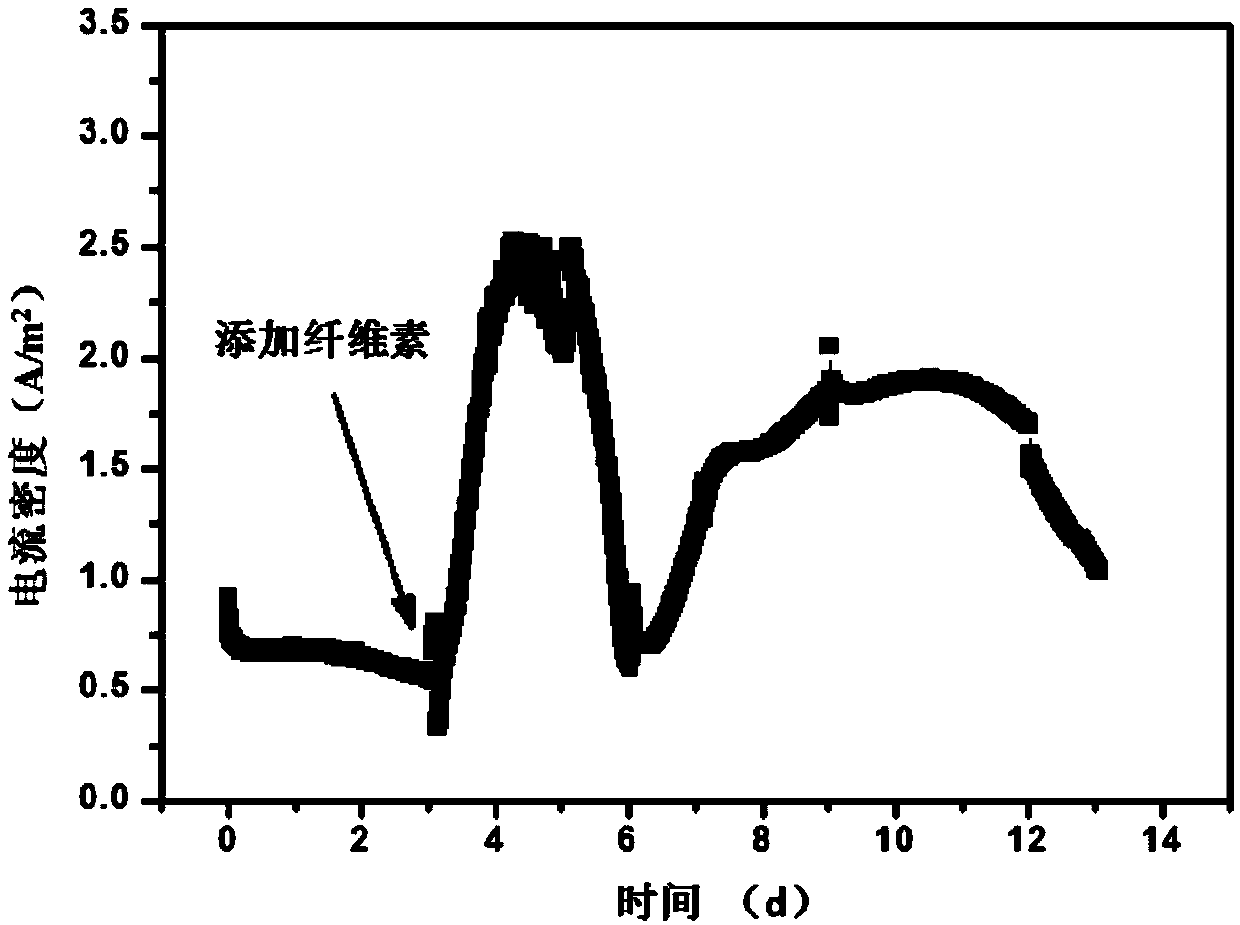Method for efficiently recovering hydrogen from cellulose by synergistically utilizing thermophilic bacterial flora based on microbial electrolytic cell
A microbial electrolytic cell and cellulose technology, applied in the field of microbial electrolytic cell hydrogen production, can solve the problems of low rate and efficiency, increased complexity and cost, shorten the cycle of hydrogen production, promote rapid hydrolysis and fermentation, and avoid system pH drastic drop in effect
- Summary
- Abstract
- Description
- Claims
- Application Information
AI Technical Summary
Problems solved by technology
Method used
Image
Examples
Embodiment 1
[0030] 1) Weigh 10.0g of compost and place it in a 120mL serum bottle, weigh 0.25g of cellulose filter paper (cut the filter paper into 1cm*1cm pieces), then add 100mL of matrix culture solution into the serum bottle, and reserve 20mL of top Empty locations to collect gas. The matrix culture solution is prepared by mixing basic matrix, trace elements, vitamin elements, selenate and cysteine hydrochloride solution, and each 1L of matrix culture solution contains 996mL of basic matrix, 1mL of trace element solution, vitamin solution (ATCC Vitamin) 1mL, selenate solution 1mL, cysteine hydrochloride 1mL, wherein each 1L basic matrix contains the following ingredients: NaCl 1.0g, NH 4 Cl 10.0g, MgCl 2 ·6H 2 O 1.0g, CaCl 2H 2 O 5.0g; every 1L trace element solution contains the following ingredients: FeCl 2 4H 2 O 2.0g, H 3 BO 3 0.05g, ZnCl 2 0.05g, CuCl 2 2H 2 O 0.038g, MnCl 2 4H 2 O 0.05g, CoCl 2 ·6H 2 O 0.05g, NiCl 2H 2 O 0.092g, (NH 4 ) 2 Mo 7 o 24 4H 2...
Embodiment 2
[0039] 1) Weigh 10.0g of compost and place it in a 120mL serum bottle, weigh 0.25g of cellulose filter paper (cut the filter paper into 1cm*1cm pieces), then add 100mL of matrix culture solution into the serum bottle, and reserve 20mL of top Empty locations to collect gas. The preparation of the matrix culture solution is the same as the matrix culture solution in Step 1 in Example 1. After the matrix culture solution was prepared, use N 2 / CO 2 =80 / 20 mixed gas The serum bottle added with compost, filter paper and matrix was aerated for 30 minutes to remove dissolved oxygen in the solution while maintaining the initial pH of the matrix at 7. After the aeration, the serum bottle was sealed and placed in a shaker at 55°C for cultivation. During the cultivation, the gas volume was measured every 2 days with a glass syringe, and the gas composition was measured with a gas chromatograph. A round of culture ends when the cellulose is completely dissolved and no gas is produced ...
Embodiment 3
[0045] 1) Weigh 10.0g of compost and place it in a 120mL serum bottle, weigh 0.25g of cellulose filter paper (cut the filter paper into 1cm*1cm pieces), then add 100mL of matrix culture solution into the serum bottle, and reserve 20mL of top Empty locations to collect gas. The culture solution includes a basic matrix, trace elements, vitamin elements, selenate and cysteine hydrochloride solution, and the preparation of the matrix culture solution is the same as the matrix culture solution in Step 1 in Example 1. After the matrix culture solution was prepared, use N 2 / CO 2 =80 / 20 mixed gas The serum bottle added with compost, filter paper and matrix was aerated for 30 minutes to remove dissolved oxygen in the solution while maintaining the initial pH of the matrix at 7. After the aeration, the serum bottle was sealed and placed in a shaker at 55°C for cultivation. During the cultivation, the gas volume was measured every 2 days with a glass syringe, and the gas compositio...
PUM
 Login to View More
Login to View More Abstract
Description
Claims
Application Information
 Login to View More
Login to View More - R&D
- Intellectual Property
- Life Sciences
- Materials
- Tech Scout
- Unparalleled Data Quality
- Higher Quality Content
- 60% Fewer Hallucinations
Browse by: Latest US Patents, China's latest patents, Technical Efficacy Thesaurus, Application Domain, Technology Topic, Popular Technical Reports.
© 2025 PatSnap. All rights reserved.Legal|Privacy policy|Modern Slavery Act Transparency Statement|Sitemap|About US| Contact US: help@patsnap.com



